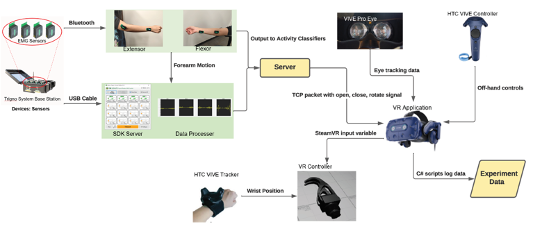3. EMG-based Assistive Human-Machine Interface Design
NSF Project
This is an NSF-funded project to develop models of powered-prosthetic user cognitive workload when applying different modes of electromyography (EMG)-based device control. Models are to be used for predicting workload associated with use of EMG-based control interfaces in other applications.
3.1 Project overview
This project is to provide engineering and design guidance for EMG-based assistive human-machine interactions for human performance of basic psychomotor and real-time, high-demand control tasks. To achieve this goal, there are three experiments. Currently we have completed the first experiment, are working on the second experiment, and are preparing for the third experiment.
1st EXPERIMENT
To identify the differences in cognitive load in using various EMG-based HMIs,first experiment made comparison of direct-control device with EMG-response pattern-recognition control, and continuous control technology. Through two tasks, CRT and SHAP, user performance data, usability evaluations and workload surveys were collected.

2nd EXPERIMENT
Second experiment makes assessment of use of EMG-based control interface with virtual reality-based simulation of prosthetic manipulations in activities of daily living. The schematic below shows the hardware setup for the experiment.

3rd EXPERIMENT
Final study will assess driver use of EMG-based control interface to perform basic driving tasks in high fidelity simulator. Work is expected to result in a set of design guidelines for EMG-based control interface designs for various applications.
3.2 Related paper
Published and Submitted paper
[1]. Liu, Y., Berman, J., Dodson, A., Park, J., Zahabi, M., Huang, H., Ruiz, J., and Kaber, D. (2022). Human-centered evaluation of EMG-based upper-limb prosthetic control schemes. Submitted to IEEE Transactions on Human-Machine Systems. Accepted (January 2024).
[4]. Park, J., Berman, J., Dodson, A., Liu, Y., Armstrong, M., Huang, H., Kaber, D., Ruiz, J., and Zahabi, M.(2023). Assessing workload in using electromyography (EMG)-based prostheses, Ergonomics, DOI: 10.1080/00140139.2023.2221413.
[C4]. Park, J., Berman, J., Dodson, A., Liu, Y., Matthew, A., Huang, H., Kaber, D. B., Ruiz, J., and Zahabi, M. (2022). Cognitive workload classification of upper-limb prosthetic devices. IEEE International Conference on Human-Machine Systems, pp. 1-6.
[C6]. Park, J., Music, A., Daniel, D., Berman, J., Dodson, A., Liu, Y., Ruiz, J., Huang, H., Kaber, D. B., and Zahabi, M. (2023). Cognitive workload and usability of virtual reality simulation for prosthesis training. IEEE International Conference on Systems, Man, and Cybernetics. pp. 1567-1572.
Working paper
[8]. Liu, Y., Delgado, D., Park, J., Music, A., Berman, J., Kaber, D., Ruiz, J., Huang, H., and Zahabi, M.. Virtual Reality (VR) in the early phase design of EMG-based upper-limb prosthetics. Submitted to Ergonomics.
[9]. Park, J., Liu, Y., Delgado, D., Music, A., Berman, J., Kaber, D., Ruiz, J., Huang, H., and Zahabi, M.. A evaluation of EMG-based upper-limb prosthetic control modes: Virtual Reality vs. physical devices. Submitted to Applied Ergonomics.